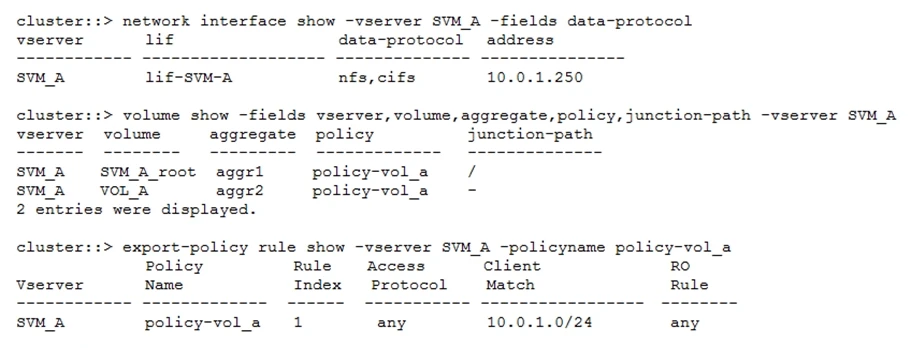
You have an SVM-DR relationship as shown in the exhibit. You are given a new requirement to use SnapMirror Synchronous (SM-S) for the data volumes in NFS-
SVM-01.
In this scenario, which solution is supported to enable SM-S in ONTAP 9.8 software?

To enable SnapMirror Synchronous (SM-S) in ONTAP 9.8 software, you need to set up new SM-S relationships originating from the AFF A220 to a new destination. This approach meets the requirement to use SnapMirror Synchronous while considering the correct setup procedures in ONTAP. You cannot simply modify an existing SVM-DR policy to use synchronous mode; a new relationship must be established.
FabricPool aggregates in ONTAP 9.8 support both StorageGRID Object Storage and S3 Object Store as capacity tiers. This is because FabricPool is designed to integrate with object storage solutions for both private clouds, like NetApp StorageGRID, and public cloud services, such as Amazon S3. These two options provide a wide range of flexibility and compatibility for users managing different storage infrastructures.

The volume is not mounted in the namespace, as indicated by the hyphen (-) in the junction-path field. This prevents the Linux host from accessing the volume despite the correct IP range and protocol permissions.
You cannot directly convert a FlexVol volume to a FlexGroup volume in ONTAP 9.1. Also, SnapMirror replication between FlexVol and FlexGroup volumes is not supported for the given ONTAP versions. To move the data, you would use a tool like XCP to copy data from the existing FlexVol to the new FlexGroup. Therefore, it is true that FlexVol to FlexGroup conversion is not supported and that XCP can be used to copy data to a FlexGroup.

The correct option to ensure that LIFs automatically revert to their home ports after an ONTAP upgrade is the auto-revert option. This setting, when enabled, ensures that the LIFs will return to their designated home ports once they become available after events such as upgrades or failures. The other options do not pertain to automatically reverting LIFs to their home ports.